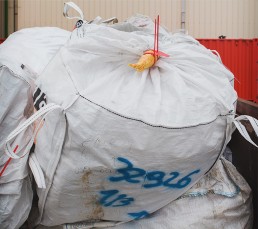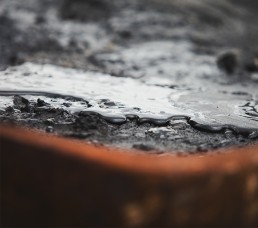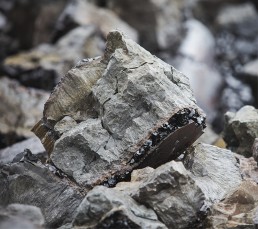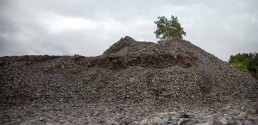There are two industrial solutions for processing asbestos waste in Europe: landfill or vitrification, as offered by INERTAM.
The INERTAM’s solution currently represents the only alternative to the landfill of asbestos waste.
A unique solution worldwildewith high added value
By bringing the asbestos waste to its fusion point at a very high temperature, INERTAM melts the asbestos fibres, and thus removes their toxicity.
1. PREPARATION OF ASBESTOS WASTE
The containers of asbestos waste are placed on an automated container carrier that can enter confined areas. The carrier passes through a three-door airlock fitted with a washing and decontamination station. The waste is then tipped onto the feed conveyor for the grinder, and the ground waste is then directed towards four storage containers according to the type of waste (silica, calcium, combustible, gypsum).
The loading conveyor for the furnace is simultaneously fed by the four ground waste storage containers. The controllers regulate the proportions of the four types of asbestos waste, as well as the requirements of the furnaces, making it possible to achieve a fine, even mixture, and thus ensure good asbestos waste fusibility.
2. VITRIFICATION OF ASBESTOS
The asbestos waste is continuously added to the fusion chamber, to bring it up to a fusion temperature of between 1,400° C and 1,600° C. The asbestos fibres are totally destroyed.
The molten material is then progressively drawn off from the smelting furnace. The molten vitrified product (called Cofalit®) is poured into cast iron ingot mould.
3. GAS PROCESSING
The gases released in the furnace are extracted and sent to the gas processing system.
4. RECYCLING OF COFALIT®, THE VITRIFIED END-PRODUCT
The molten bath is cast into a mould, which is placed in a storage area to cool in the open air. The mould is then turned out and the Cofalit® is stored on a storage platform before being crushed, with a view to being reused as a road-building substrate.
Recycling of asbestos waste :Cofalit®
Cofalit®, a material obtained from the fusion of asbestos waste, is inert and reusable. This material is mainly reused as aggregate, to form a road-building substrate.
Other uses are being examined, particularly for the storage of solar energy.







